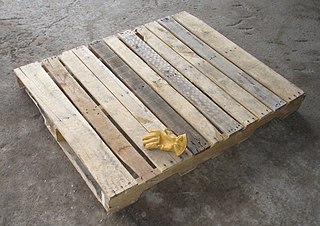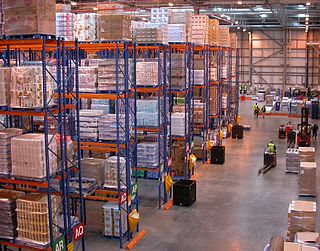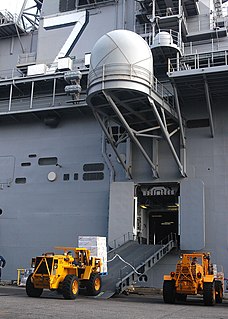Electronic data interchange (EDI) is the concept of businesses electronically communicating information that was traditionally communicated on paper, such as purchase orders and invoices. Technical standards for EDI exist to facilitate parties transacting such instruments without having to make special arrangements.
Cross-docking is a practice in logistics of unloading materials from an incoming semi-trailer truck or railroad car and loading these materials directly into outbound trucks, trailers, or rail cars, with little or no storage in between. This may be done to change the type of conveyance, to sort material intended for different destinations, or to combine material from different origins into transport vehicles with the same or similar destinations.

A pallet is a flat transport structure, which supports goods in a stable fashion while being lifted by a forklift, a pallet jack, a front loader, a jacking device, or an erect crane; sometimes, a pallet is inaccurately called a skid. A pallet is the structural foundation of a unit load which allows handling and storage efficiencies. Goods or shipping containers are often placed on a pallet secured with strapping, stretch wrap or shrink wrap and shipped. Since its invention in the twentieth century, its use has dramatically supplanted older forms of crating like the wooden box and the wooden barrel, as it works well with modern packaging like corrugated boxes and intermodal containers commonly used for bulk shipping.
Amtrak Express is Amtrak's freight and shipping service. It handles small package express service, heavy freight shipments and city-to-city freight shipping by private and commercial customers. Boxes up to 36" x 36" x 36", suitcases, and boxed bicycles are acceptable, but numerous classes of fragile, valuable and hazardous items are not permitted. Large pallet shipments of up to 500 pounds (227 kg) are accepted at certain major stations. Quoted transit times range from 2 to 7 days depending on distance and service frequency.

A distribution center for a set of products is a warehouse or other specialized building, often with refrigeration or air conditioning, which is stocked with products (goods) to be redistributed to retailers, to wholesalers, or directly to consumers. A distribution center is a principal part, the order processing element, of the entire order fulfillment process. Distribution centers are usually thought of as being demand driven. A distribution center can also be called a warehouse, a DC, a fulfillment center, a cross-dock facility, a bulk break center, and a package handling center. The name by which the distribution center is known is commonly based on the purpose of the operation. For example, a "retail distribution center" normally distributes goods to retail stores, an "order fulfillment center" commonly distributes goods directly to consumers, and a cross-dock facility stores little or no product but distributes goods to other destinations.
A warehouse management system (WMS) is a software application, designed to support and optimize warehouse functionality and distribution center management. These systems facilitate management in their daily planning, organizing, staffing, directing, and controlling the utilization of available resources, to move and store materials into, within, and out of a warehouse, while supporting staff in the performance of material movement and storage in and around a warehouse.
Truckload shipping is the movement of large amounts of homogeneous cargo, generally the amount necessary to fill an entire semi-trailer or intermodal container. A truckload carrier is a trucking company that generally contracts an entire trailer-load to a single customer. This is as opposed to a less-than truckload (LTL) company that generally mixes freight from several customers in each trailer. One advantage Full Truckload (FTL) carriers have over Less than Truckload carriers is that the freight is never handled en route, whereas an LTL shipment will typically be transported on several different trailers.
A freight rate is a price at which a certain cargo is delivered from one point to another. The price depends on the form of the cargo, the mode of transport, the weight of the cargo, and the distance to the delivery destination. Many shipping services, especially air carriers, use dimensional weight for calculating the price, which takes into account both weight and volume of the cargo.
Less than truckload shipping or less than load (LTL) is the transportation of relatively small freight. The alternatives to LTL carriers are parcel carriers or full truckload carriers. Parcel carriers usually handle small packages and freight that can be broken down into units less than 150 pounds (68 kg). Full truckload carriers move freight that is loaded into a semi-trailer. Semi-trailers are typically between 26 and 53 feet and require a substantial amount of freight to make such transportation economical.

An automated storage and retrieval system consists of a variety of computer-controlled systems for automatically placing and retrieving loads from defined storage locations. Automated storage and retrieval systems (AS/RS) are typically used in applications where:
Material handling equipment is mechanical equipment used for the movement, storage, control and protection of materials, goods and products throughout the process of manufacturing, distribution, consumption and disposal. The different types of handling equipment can be classified into four major categories: transport equipment, positioning equipment, unit load formation equipment, and storage equipment.

A unit load combines individual items or items in shipping containers into single "units" that can be moved easily with a pallet jack or forklift truck. A unit load packs tightly into warehouse racks, intermodal containers, trucks, and boxcars, yet can be easily broken apart at a distribution point, usually a distribution center, wholesaler, or retail store.

Material handling involves short-distance movement within the confines of a building or between a building and a transportation vehicle. It uses a wide range of manual, semi-automated, and automated equipment and includes consideration of the protection, storage, and control of materials throughout their manufacturing, warehousing, distribution, consumption, and disposal. Material handling can be used to create time and place utility through the handling, storage, and control of material, as distinct from manufacturing, which creates form utility by changing the shape, form, and makeup of material.
Order processing is the process or work-flow associated with the picking, packing and delivery of the packed items to a shipping carrier. Order processing is a key element of order fulfillment. Order processing operations or facilities are commonly called "distribution centers".

In North America, a roll-off is a usually open top dumpster characterized by a rectangular footprint, utilizing wheels to facilitate rolling the dumpster in place. The container is designed to be transported by special roll-off trucks. Roll-offs are commonly used to contain loads of construction and demolition waste or other waste types. While most roll-off containers have a swinging door on the end for easier disposal of waste, some roll-off containers are not open top and are used with commercial or industrial trash compactors.
Parcel audit is the process of reviewing shipping invoices for invalid charges and other billing inaccuracies. Each shipment tendered to a major parcel carrier like UPS and FedEx come with service guarantees outlined within each carrier's tariff or service guide. An increasing number of businesses contract third-party companies to perform these services because they have the technology necessary to automate the otherwise time consuming process.

Corrugated box design is the process of matching design factors for corrugated fiberboard boxes with the functional physical, processing and end-use requirements. Packaging engineers work to meet the performance requirements of a box while controlling total costs throughout the system.
By definition an audit is,









